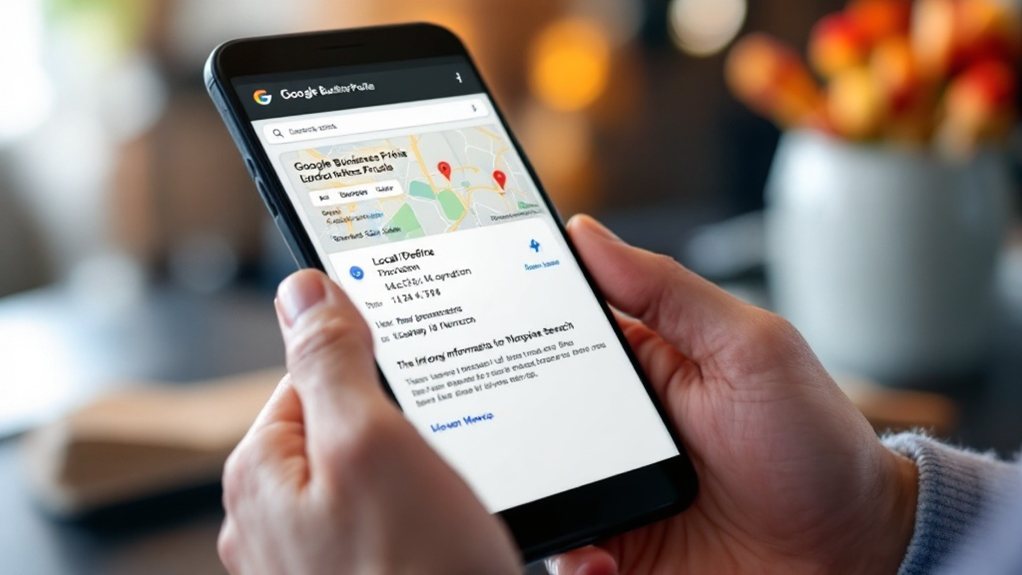To optimize your content for local voice search, start by claiming and verifying your Google Business Profile. Ensure your business details are up-to-date and incorporate relevant local keywords. Use long-tail, question-based searches to target local intent. Structure your content for featured snippets with clear headings, concise responses, and schema markup. Improve your technical performance by compressing images and minimizing page load times. By focusing on these key strategies, you'll be well on your way to boosting your visibility and driving more localized engagement. There's more to explore when it comes to leveraging voice search for your business.
Understanding the Importance of Local Voice Search

As the prevalence of voice search continues to rise, understanding the importance of local voice search has become paramount for businesses. With 55% of people using voice search to find local businesses and 46% of smart speaker users performing voice searches daily for local information, optimizing for local voice queries is crucial. Voice-enabled device interaction is becoming a part of consumers' day-to-day routine, as 65% of 25-49-year-olds speak to voice-enabled devices at least once per day. Smart speaker owners heavily leverage voice search for local business discovery, and mobile users are three times more likely to use voice search. Businesses that seize this opportunity can gain a competitive edge, as voice search often leads to immediate customer actions like calling or visiting.
Optimizing Google Business Profile for Voice Search

Claiming and verifying your Google Business Profile is crucial for accurate representation. Ensure your business details, like hours, address, and phone number, are up-to-date for voice search optimization. Incorporate relevant local keywords throughout your profile to enhance visibility and relevance in local voice searches. Positive customer reviews can help a business rank higher in voice search results, which is a key aspect of effective voice search optimization.
Accurate Business Details
Ensuring accurate business details in your Google Business Profile is crucial for voice search optimization. Accurate business information helps Google better understand and match your company with relevant queries. This includes:
- Consistently displaying your correct business name and address across all platforms
- Carefully selecting the appropriate primary category for your services
- Maintaining up-to-date contact details like phone numbers and websites
- Clearly stating your hours of operation to meet user needs
- Verifying your profile to establish authenticity and build trust
- Voice search uses A.I. to hear and interpret user intentions to return relevant results.
Optimized for Local Search
Optimizing your Google Business Profile is pivotal for voice search success. Incorporate keyword-rich descriptions to enhance visibility. High-quality photos engage users visually, while listing specific attributes like wheelchair accessibility supports targeted queries. Leveraging Google Posts can keep content fresh and relevant. Integrate booking links to streamline customer interactions and support voice search convenience. Maintaining consistent information across your Google Business Profile, website, and social media platforms reinforces your brand and trustworthiness. Regularly review your profile performance to identify optimization opportunities. By optimizing your online presence, you'll position your business for increased visibility and engagement in local voice search results.
Leveraging Long-Tail Keywords for Local Queries

Leveraging long-tail keywords is a crucial component of effective local voice search optimization. These specific, conversational phrases align with the natural language used in voice queries, improving your visibility and relevance. Compared to organic SEO, local SEO is much more time sensitive. To capitalize on long-tail keywords:
- Focus on question-based searches that reflect local intent, such as "where is the best Italian restaurant near me?"
- Optimize your content to seamlessly incorporate these keywords, creating a natural and conversational tone.
- Ensure your Google Business Profile and local directory listings are up-to-date to enhance your local SEO.
- Monitor your performance and adjust your strategies based on voice search metrics to stay ahead of the competition.
Structuring Content for Featured Snippets
Although voice search queries tend to be longer and more conversational, you can structure your content to effectively target featured snippets. By using clear headings, concise responses, and lists or bullet points, you can improve the readability and clarity of your content. Additionally, applying schema markup can help search engines better understand the structure of your information, increasing the likelihood of your content appearing in voice search results. Incorporating relevant, conversational keywords into your content is crucial for voice search optimisation.
| Featured Snippet Formats | Suitable Content |
|---|---|
| Paragraph | Succinct answers to questions |
| List | Step-by-step instructions or information presentation |
| Table | Comparative data or statistics |
Crafting content that directly addresses user queries with brevity and clarity is key to enhancing your visibility in voice search through featured snippets.
Improving Technical Performance for Mobile Voice Search
How can you improve the technical performance of your website to better support mobile voice search? Focus on mobile-first design, responsive layouts, fast navigation, and interactive elements. Regularly test across devices to ensure consistency and functionality.
- Compress images to reduce page load times without compromising quality.
- Leverage browser caching to store frequently accessed resources locally.
- Minimize and optimize CSS and JavaScript files for faster page loading.
- Utilize SEO tools to monitor and improve page speed, ensuring an average load time of 4.6 seconds.
- Optimizing for voice search can boost visibility and rankings in voice-activated search results.
Creating Conversational and User-Friendly Content
To create conversational and user-friendly content for local voice search, you'll want to mimic everyday speech patterns. Structure your content for optimal readability, keeping sentences and paragraphs concise. This will help your content resonate with voice search users seeking direct, actionable information. Focusing on natural language is crucial to optimizing for the question-based queries that are common in voice search.
Mimicking Everyday Speech
As you aim to optimize for voice search, it's crucial to create content that mimics everyday speech patterns. By incorporating natural language and conversational tone, you can enhance the relevance and accessibility of your content for voice search users.
Some key considerations include:
- Embracing Contractions: Using contractions like "can't," "won't," and "doesn't" makes your content sound more natural and human-like.
- Asking Questions: Incorporating question-based keywords like "how" and "where" reflects the way people naturally ask for information.
- Simplifying Vocabulary: Using plain, everyday language instead of complex jargon enhances comprehension and appeal for voice search users.
- Maintaining Concision: Providing succinct, to-the-point responses aligns with the expectations of voice search users.
Optimizing content for local voice search is another important consideration, as users often search for nearby businesses or services.
Structuring for Readability
Structuring your content for readability is paramount when optimizing for voice search. Provide direct and concise responses to your audience's queries, using short sentences to enhance comprehension. Organize your content with clear headers and bullet points, making it easy to scan and understand. Craft engaging meta descriptions that align with voice search queries, and incorporate long-tail keywords that reflect conversational speech patterns. Ensure your website loads quickly and is mobile-friendly, prioritizing simplicity in design to avoid clutter. By focusing on creating conversational and user-friendly content, you'll improve your chances of appearing in voice search results and providing a positive experience for your local audience.
Targeting Different User Intents in Local Voice Search
Understanding the varying intents of local voice search users is crucial for optimizing your content and delivering the most relevant information. Whether your audience is seeking informational, transactional, or local content, tailoring your approach is key. Craft question-based keywords, provide concise answers, and ensure seamless mobile experiences. Leverage FAQ pages, incorporate long-tail keywords, and optimize for local SEO to boost visibility. Remember:
- Voice search queries often use full sentences and conversational language.
- Users with transactional intent are looking to take immediate action.
- Local intent focuses on finding nearby businesses or services.
- Analyze search engine results pages to understand the competition.
Analyzing Local Voice Search Trends and Insights
Analyzing local voice search trends and insights is crucial for businesses aiming to stay ahead of the curve. As voice searches increasingly dominate web browsing, understanding evolving user behaviors and preferences is key. Consider the rise of multi-intent queries, the need for hyper-local content, and the importance of a privacy-first approach. Leverage these insights to optimize your local SEO strategy:
| Trend | Impact |
|---|---|
| Growing voice search usage | 30% of web browsing will be voice-based |
| Local intent dominance | 58% of voice searches are for local business info |
| Conversational search phrases | Optimize for everyday speech patterns |
Integrating Schema Markup for Enhanced Visibility
As businesses seek to stay ahead in the evolving world of local voice search, it's crucial to recognize the importance of integrating schema markup into your optimization strategy. Properly implemented schema markup helps search engines understand the content and context of your webpages, enhancing their visibility and relevance in voice search results. This structured data can provide clear information about your business, such as your address, hours of operation, and customer reviews – all of which are essential for local voice searches.
Consider these benefits of integrating schema markup:
- Improved Local Visibility: Schema markup boosts your presence in local search results, making it easier for users to find your business.
- Accurate Voice Search Answers: Schema helps digital assistants provide precise and reliable information to voice search queries.
- Enhanced User Experience: Visually appealing rich snippets and clear content organization improve the overall user experience.
- Increased Credibility: Displaying customer reviews through schema can enhance your local reputation and trustworthiness.
Measuring and Tracking Local Voice Search Performance
Measuring local voice search performance is crucial for optimizing your strategies. Utilize tools like Google Analytics 4 and Google Search Console to track your mobile traffic, engagement metrics, and user intent. Continuously monitor your progress and adapt your content to improve your visibility in local voice search results.
Local Visibility Metrics
Tracking your local voice search performance is crucial for gauging the effectiveness of your optimization efforts. By analyzing key metrics, you can refine your strategy and improve your local business's visibility. Consider monitoring:
- Click-Through Rates: Measure how often users engage with your voice search results to assess their relevance.
- Bounce Rates: Evaluate how quickly users leave your site, indicating the need to enhance content and user experience.
- Conversion Rates: Track the percentage of voice search visitors who take desired actions, such as making a purchase or booking an appointment.
- Mobile Traffic Shares: Analyze the proportion of mobile traffic to ensure your voice search optimization is resonating with on-the-go customers.
Voice Search Analytics
Monitoring your local voice search performance is essential for refining your optimization strategy and enhancing your business's online visibility. Tools like Google Search Console, SEMrush, and Ahrefs can provide insights into keyword rankings, featured snippet appearances, and mobile traffic. Pay attention to user engagement metrics like time on page and bounce rates to gauge content effectiveness. Tracking conversion rates from voice search is crucial for measuring the impact on your business goals. However, challenges exist in capturing direct answers from voice assistants and integrating voice search with your existing SEO efforts. Focusing on optimizing for local, conversational keywords and enhancing user experience can help you stay ahead in the evolving voice search landscape.
Performance Benchmarking
Analyzing your local voice search performance is key to refining your optimization strategy and boosting your business's online visibility. Track conversion rates from voice queries, engagement metrics like bounce rate and pages per session, and location-specific data to understand how users interact with your content. Focus on intent-based optimization and monitor mobile traffic patterns, as most voice searches happen on the go. Integrate these insights to create a powerful long-tail keyword strategy that aligns with how people speak.
- ✓ Identify gaps in competitors' voice search optimization
- ✓ Ensure your website is mobile-friendly and loads quickly
- ✓ Leverage Google My Business to improve local visibility
- ✓ Utilize powerful analytics tools to monitor performance
